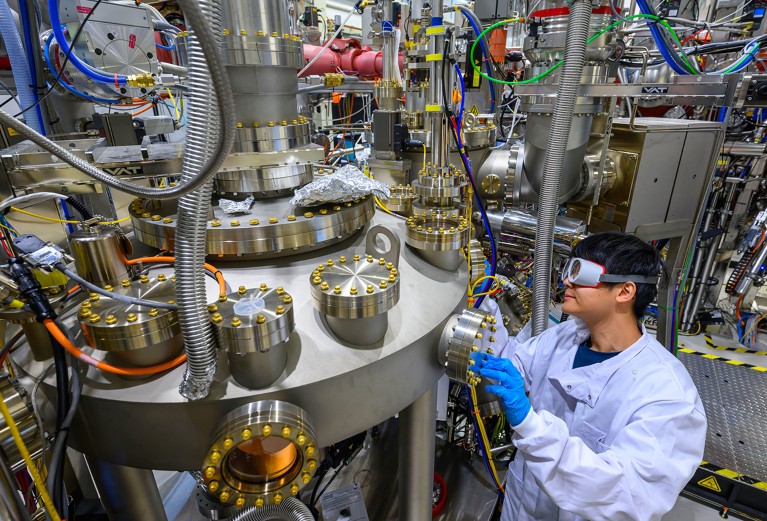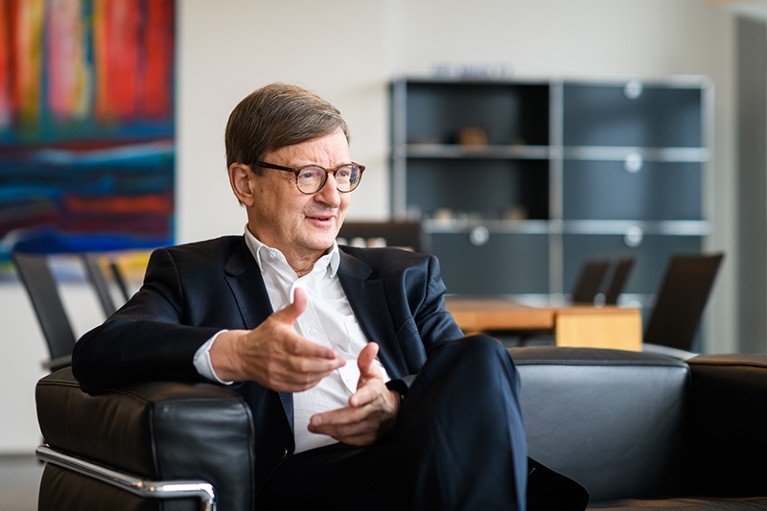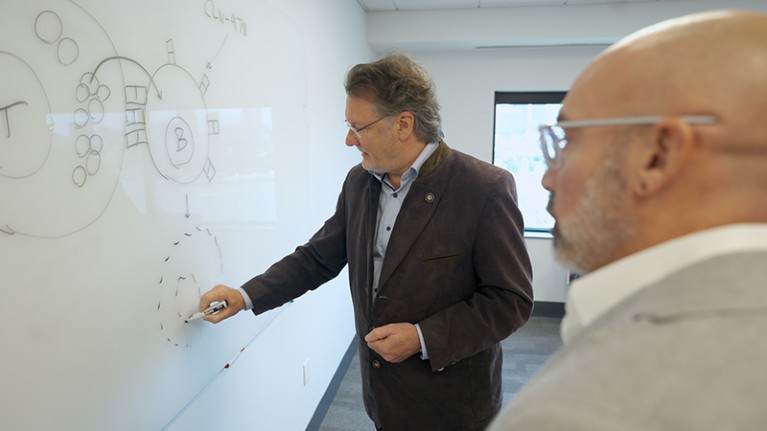
The Max Planck Institutes in Germany house cutting-edge equipment, such as this ultra-high vacuum facility at The Max Planck Institute of Microstructure Physics in Halle. Credit: Hendrik Schmidt/dpa/ALAMY
In 2019, shortly after finishing her master’s at Nanjing University in China, Xinyi Zhao opened an e-mail to learn that she had been offered a PhD position at the Max Planck Institute for Demographic Research in Rostock, Germany. “When I told my parents, they asked me to double-check whether the offer was real, as they weren’t familiar with the institute.” But Zhao knew of its glowing scientific reputation. “I felt very excited but also quite surprised,” says Zhao. “I heard they do amazing research.” Six years on, she’s still happily employed in Germany, now as a postdoc at the Berlin-based Max Planck Institute for Human Development.
Nature Career Guide: Germany
Between 2012 and 2022, the number of international scientists at the country’s four largest non-university research organizations doubled, from 8,115 to 16,6251. These institutes — the Max Planck Society, the Leibniz Association, the Helmholtz Association of German Research Centres and the Fraunhofer Society — all ranked among the world’s top 20 non-profit organizations for research output in 2025, according to the Nature Index Research Leaders. The country’s universities also maintain a strong international profile, with 8 included in the world’s top 100, as reported in the Times Higher Education’s 2026 World University Rankings.

Xinyi Zhao, a postdoc at the Max Planck Institute for Human Development in Berlin, likes the research environment in Germany. Credit: Sarah Otterstetter / Max Planck Institute for Human Development
Germany’s success in academic-excellence rankings lies partly in the structure of its scientific ecosystem — in which each research organization specializes in a particular kind of science — alongside the remarkably stable flow of public research funding. “Germany is a country without natural resources,” says Otmar Wiestler, former president of the Helmholtz Association. “We don’t have cheap labour. All we have is the brains of our people.” As a result, he adds, “the German government is really committed to promoting research and innovation”.
Streamlined systems
In 2023, around 3.1% of Germany’s gross domestic product (GDP) — roughly €132 billion (US$152 billion) — was spent on research and development, a lower percentage than those of Israel (6%) and the United States (3.4%), but higher than the relative research spending of the United Kingdom (2.6%) and China (2.7%). Around one-third of this spending was from the public sector and the rest came from private industry. German governmental support for science has remained stable throughout various political leaderships. In the past 20 years, “we have never had a year where federal spending has decreased”, says Max Voegler, the vice-president of Global Strategic Networks for Germany, Austria and Switzerland at the Amsterdam-based academic publisher Elsevier, who co-wrote a report on Germany’s research system earlier this year2.
Although the bulk of the funding for research and teaching in countries such as France and the United Kingdom comes from the central governments, in Germany, the task of supporting academic activities falls to both federal and state governments. These jointly provide the majority of the institutional funding for most of the country’s non-university research organizations. And in contrast to the United States and the United Kingdom, where universities draw much of their income from tuition fees, German states are responsible for providing the base funding for universities.

Otmar Wiestler, former president of the Helmholtz Association, says that the German government is committed to promoting research and innovation.Phil Dera/Helmholtz
Funding flows into a highly structured research ecosystem consisting of more than 420 universities, most of which are public, and four main non-university research organizations. Each of the four fulfils a defined, specialized task, says Rainer Frietsch, a specialist in science-and-innovation research at the Fraunhofer Institute for Systems and Innovation Research. The Max Planck Society, for instance, focuses on fundamental research, with each of its 84 institutes around the country specializing in a range of fields, such as animal behaviour and neurogenetics. The Leibniz Society’s institutes strive to integrate scientific knowledge into society by giving economic reports and providing museums that conduct research and communicate findings. The Helmholtz Association’s centres house some of the country’s largest pieces of research equipment, including the world’s largest artificial sun, used in the study of solar processes.
The 75 institutes of the Fraunhofer Society, meanwhile, fulfil the distinct task of conducting applied research; for instance, researchers at the Fraunhofer Institute for Solar Energy Systems in Freiburg are developing more-efficient solar cells, and scientists at the Fraunhofer Institute for Manufacturing Technology and Advanced Materials, which has several centres across Germany, are identifying innovative non-stick coatings for food-processing tools. Some of the society’s projects are for and funded by industry partners. Many countries, including France, the United Kingdom and China, have tried to emulate the Fraunhofer model in some form, but it works best in Germany’s research landscape, according to Frietsch. “Fraunhofer is as successful as it is because the whole system has exactly the layout that it has,” he says: the defined task division of the research organizations efficiently avoids overlap.
Although distinct in their operations, Germany’s universities and non-university research organizations aren’t siloed from one another, says Voegler; universities often work with the non-university institutions nearby. In 2005, partly as a way of encouraging collaboration, the federal and the state governments launched the Excellence Initiative, which includes funding for interdisciplinary research projects at clusters of institutions.
From 2026 to 2032, the initiative — now called the Excellence Strategy — has pledged €539 million per year for 70 ‘clusters of excellence’ projects across the country. One of these is the Cardio–Pulmonary System Cluster of Excellence in the state of Hessen, which brings together researchers from Goethe University Frankfurt, Justus Liebig University Giessen and the Max Planck Institute for Heart and Lung Research in Bad Nauheim to study heart and lung disease. By promoting the exchange of expertise across research entities, “suddenly the whole becomes much more than the sum of its parts”, Voegler says.
Championing discovery
During discussions on European Union science-funding programmes, some member states have expressed a desire to invest mainly in applied research, Wiestler says. But German representatives have defended the need to focus on fundamental, ‘blue sky’ research — work for which practical applications aren’t immediately obvious. Enrico Schleiff, the president of Goethe University Frankfurt, attributes the emphasis on basic research to the fact that freedom of science is a constitutional right in Germany, enabling scientists to determine the direction of their research without government or political influence — something he says has led to many fruitful discoveries.
Some of those impactful discoveries include the development of blinatumomab, the first T-cell engager drug, which coaxes patients’ immune cells into attacking leukaemia cells. More recently, scientists at Friedrich-Alexander University of Erlangen–Nuremberg were part of a team that discovered that these and other kinds of cancer immunotherapies could also be used to target the dysfunctional, body-attacking immune cells responsible for causing autoimmune diseases such as lupus. “Now the whole world is developing T-cell engagers” for this purpose, says Patrick Baeuerle, a biotechnology entrepreneur and the co-founder and chief scientific advisor of Cullinan Therapeutics, a company in Cambridge, Massachusetts, that licensed a T-cell engager drug from a China-based biotech firm in June.

Patrick Baeuerle is a biotechnology entrepreneur and the co-founder and chief scientific adviser of Cullinan Therapeutics in Cambridge, Massachusetts.Credit: Cullinan Therapeutics
One of Germany’s long-standing weaknesses, Wiestler says, is that its research products are seldom commercialized in the country, because it lacks the kind of start-up culture and abundant sources of venture-capital funding that supports the biotech scene in countries such as the United States and Israel. That’s partly why the Helmholtz Association, for instance, has been increasingly establishing partnerships with companies to translate findings into marketable products. One example is the creation in 2023 of the Solar TAP Innovation platform — a joint venture between several Helmholtz Centres and industry partners to develop innovative solar technologies — and the Joint Innovation Lab, a collaboration between the German Cancer Research Center and the Hamburg-based skincare company Beiersdorf to develop strategies to prevent skin cancer.



